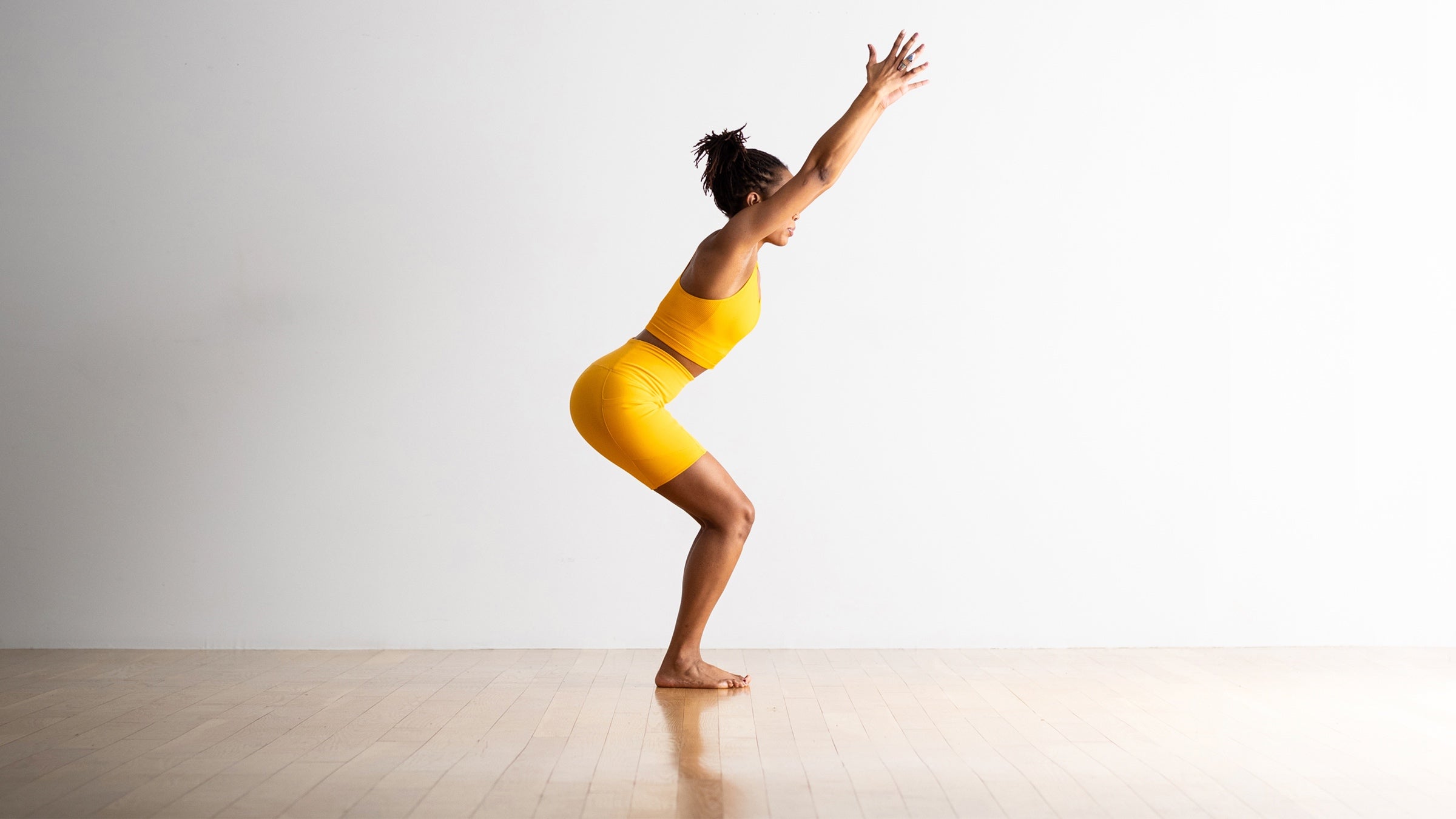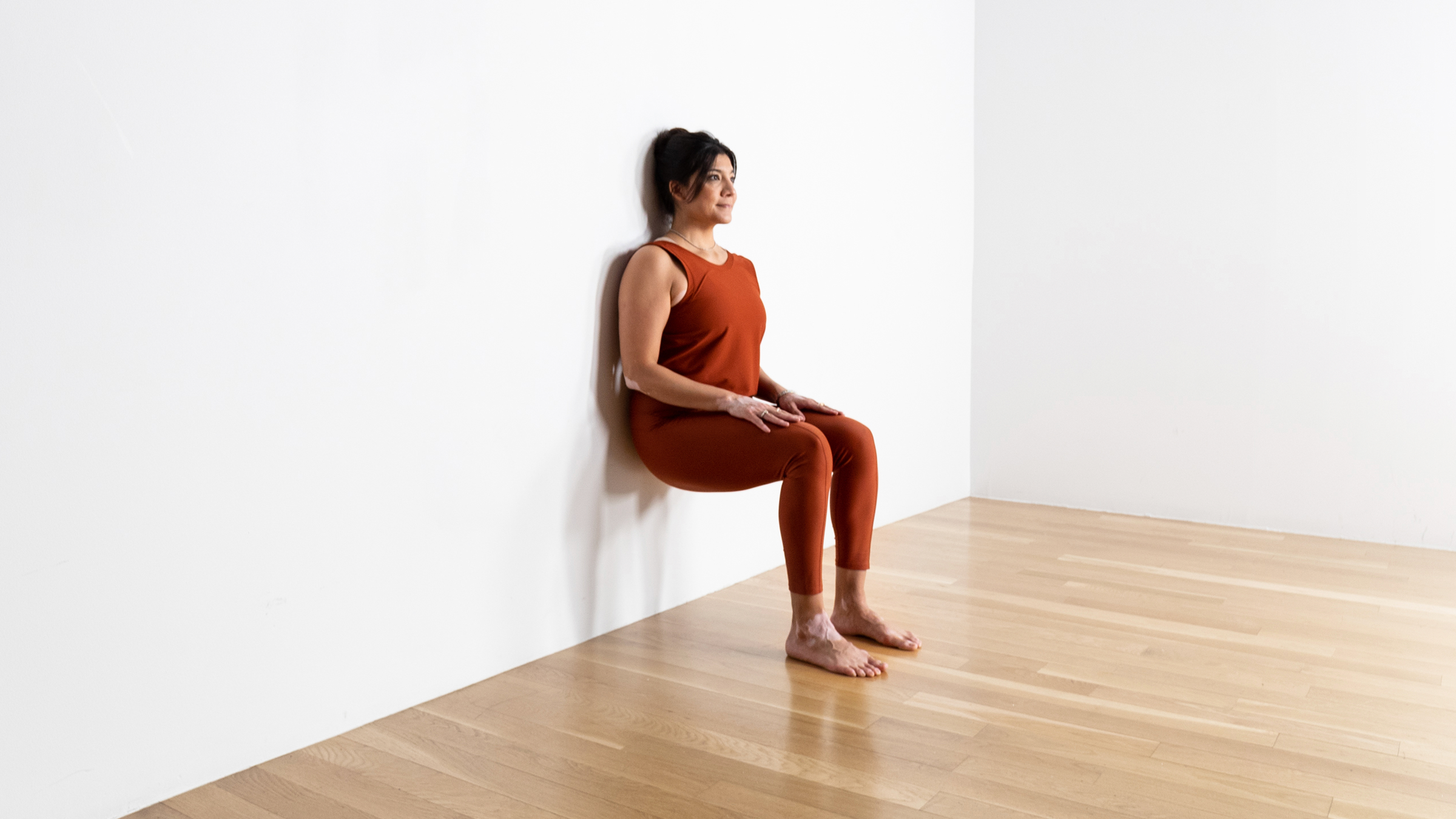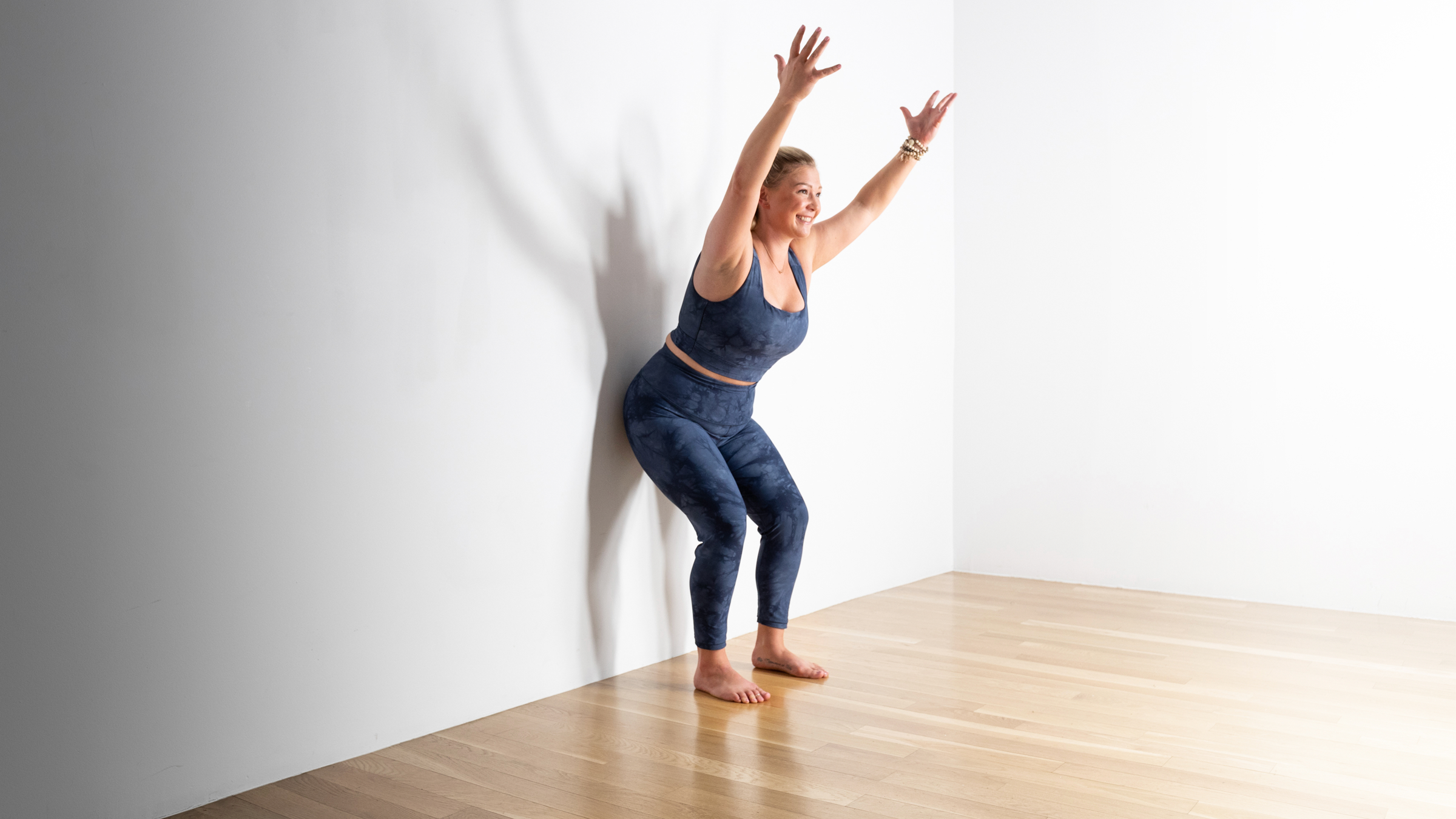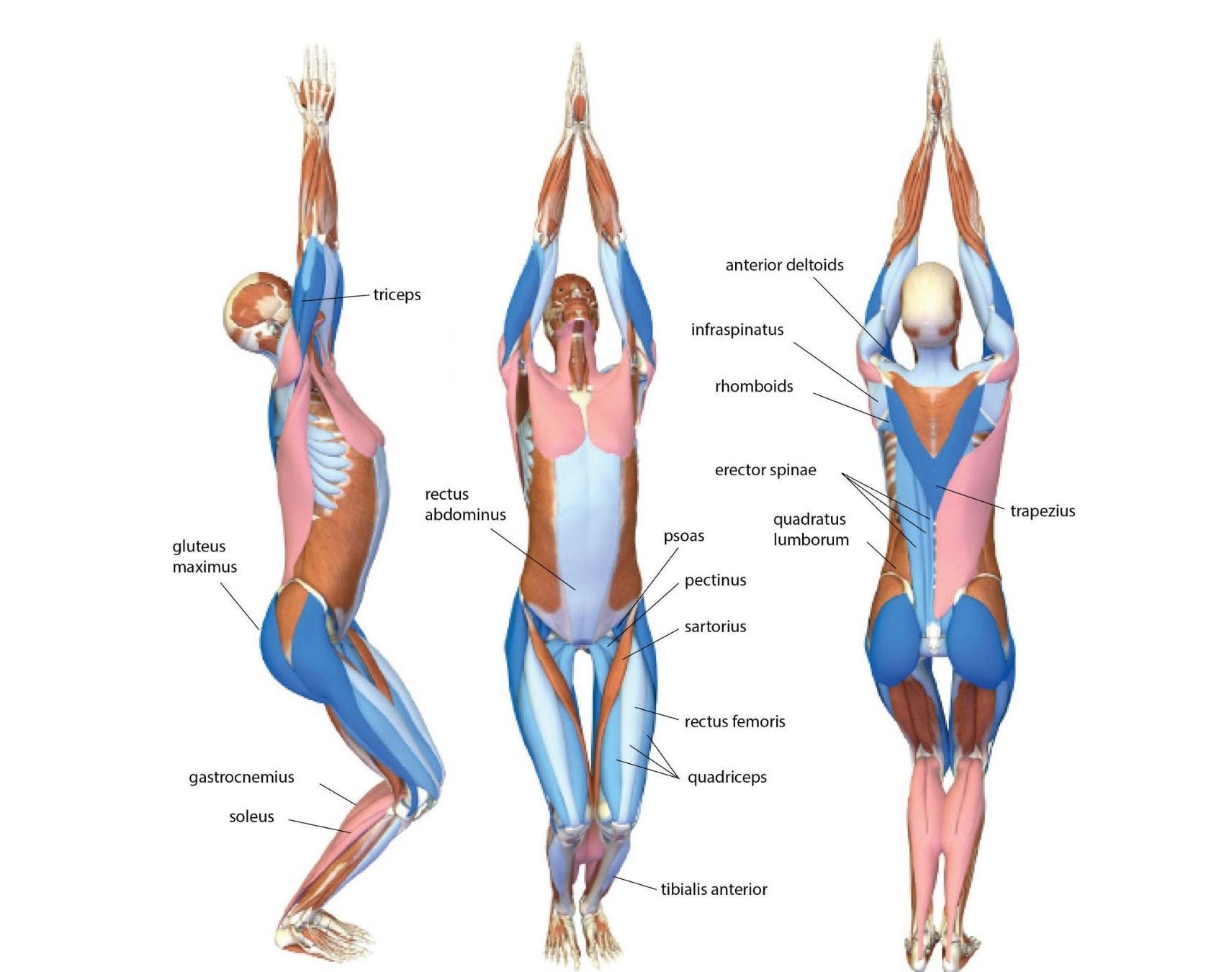If you buy through our links, we may earn an affiliate commission. This supports our mission to get more people active and outside.Learn about Outside Online's affiliate link policy
Chair Pose

(Photo: Andrew Clark)
Utkatasana (Chair Pose) is sometimes translated from Sanskrit to English as “Fierce Seat” or “Powerful Pose.” It is a strengthening and heat-building asana that brings all parts of your body together into a cohesive and powerful whole.
This asana is a meditation on determination and perseverance, as well as commitment. To successfully perform Chair Pose, you must seamlessly unite the strength of the legs, arms, and torso as you lift your core muscles and lengthen your spine.
Utkatasana can look simple—like a yogi sitting in an imaginary chair. “When you do the pose, however, it is definitely not a cushy, passive ride,” says Shiva Rea, the founder of Prana Vinyasa Yoga. “A deep squat, Utkatasana immediately engages the strength of your legs, back, and ankles. Here, power is not about domination or control over someone else so much as it is about aligning with the life energy within and around you. At the core level, Utkatasana teaches you how to find your seat of power within your pelvis, at the center of your body.”
Chair Pose demands strength and stamina in the body, but also focus in the breath and mind. When you are centered and aligned in the posture, you’ll feel like you’re accessing a great well of energy. Utkatasana offers a powerful lesson and a key concept in yoga: Steady practice over time is better than occasional, intense spurts. Consistency in yoga, and in Utkatasana, yields deep and lasting results.
Sanskrit
Utkatasana (OOT-kah-TAHS-ah-nah)
utkata = powerful, fierce
How to
- Stand in Tadasana. Inhale and raise your arms overhead so that your biceps are just slightly in front of your ears. Either keep the arms parallel, palms facing inward, or join the palms.
- Exhale and bend your knees so that your thighs are as parallel to the floor as possible. Your knees will project out over your feet, and your trunk will lean slightly forward over your thighs until your front torso forms approximately a right angle with the tops of your thighs.
- Keep your inner thighs parallel to each other and press the heads of the thigh bones down toward your heels.
- Firm your shoulder blades against your back. Direct your tailbone down toward the floor and in toward your pubis to keep your lower back long.
- Stay for 30 seconds to a minute. To come out of this pose, straighten your knees with an inhalation, lifting strongly through your arms. Exhale and release your arms to your sides into Tadasana.
Variations

Chair Pose with a block
Hold a block between your thighs to further activate your inner thigh muscles (adductors).

Chair Pose against a wall
Stand with your back against the wall, then slowly walk your feet forward, lowering down into the pose. Keep your feet at hip-distance apart. Make sure your knees are directly over your ankles, not in front of them. Stay for several breaths to several minutes.

Chair Pose against a wall, arms raised
Try the variation above, then slowly lift your arms up into a big V shape. If you feel stable, lean forward, keeping your hips against the wall. Stay for several breaths to several minutes, then bring your back to the wall again and slowly walk your feet back toward the wall to come up and out of the pose.
Chair Pose basics
Pose type: Standing balance
Target area: Lower body
Benefits: Chair Pose improves balance and can build cardiovascular health and resilience. It particularly strengthens your core, thighs, and ankles.
Beginner tips
The secret to a stable Utkatasana is releasing the heads of your thigh bones toward your heels. In the pose, bring your hands to the tops of your thighs. Nestle the base of your palms into your hip creases and push your thighs toward your heels, pressing your heels into the floor. Against these actions, lift your sitting bones up into the pelvis. Practice here until you can hold the pose without compromising the bend in your knees and hips. Then progress to lifting the arms overhead.
If you have tight shoulders, bring your arms up and overhead only as much as you can rather than back alongside your ears. Alternately, bring your hands to Anjali mudra with thumbs to your breastbone.
If you feel winded, try practicing with your arms straight out in front, down by your sides, or in Anjali mudra.
Explore the pose
As you sit back in Chair, feel the consolidation of your energy in your pelvis, your seat of power. Try not to fight or resist the strength of the pose. Focus on creating strength in the legs and squeeze your thighs and knees together to create stability. Reflect on developing confidence, courage, and faith here.
Meditation during Utkatasana can be a powerful asset. Think of it as building fire in the belly but keeping your mind cool. Keep in mind that breath is the key to remaining calm and centered in Utkatasana. Breathe mindfully, sinking a little deeper with the exhalation, lifting the arms and torso higher with the inhalation.
Why we love this pose
“I’ve written poems about Chair Pose, that’s how much I love it,” says yoga teacher, writer, and YJ contributor Rina Deshpande. “I am moved by how Utkatasana is not just about holding the heat-building chair posture. By ending with a bow of refreshing relief and standing back up again stronger than you had before, Chair is a whole circle of physical strengthening, warmth, and self esteem. To me, it’s an immediate boost of confidence and joy!”
Teacher tips
These tips will help protect your students from injury and help them have the best experience of the pose:
- Remind students to be conscious of their knees in this pose. They should shift their weight back toward their heels to keep their knees safe.
- Advise students to keep the head and neck in line with the rest of the spine. Instead of looking up, have them rest their gaze on the floor a few feet in front of them.
Preparatory and counter poses
Preparatory poses
Urdhva Hastasana (Upward Salute)
Ardha Uttanasana (Standing Half Forward Bend)
Counter poses
Uttanasana (Standing Forward Bend)
Setu Bandha Sarvangasana (Bridge Pose)
Adho Mukha Svanasana (Downward-Facing Dog)
Anatomy
Utkatasana suggests potential energy waiting to be unleashed. It uses the concept of simultaneous ascent and descent to create this energetic effect, explains Ray Long, MD, board-certified orthopedic surgeon and yoga instructor.
Several actions contribute to this. The downward forces include pressing the feet into the mat, flexing the hips to tilt the pelvis forward, and engaging the glutes to tilt the pelvis downward from the back. The ascending forces include activating the erector spinae and quadratus lumborum to lift the torso. When you draw the shoulder blades toward the midline and down the back, the chest opens and lifts upward. Raising the arms also builds upward tension.
In the drawings below, pink muscles are stretching and blue muscles are contracting. The shade of the color represents the force of the stretch and the force of contraction. Darker = stronger.

Chair Pose strengthens several core muscle groups, including the low back muscles, quadriceps, and the hip flexors, as well as the psoas, pectineus, rectus femoris, and satorius, which hold the femurs in a fixed position.
The quadratus lumborum activates to arch the lower back. The erector spinae muscles synergize this action. The psoas provides a counterbalance to the back muscles, which protects the lumbar spine. The rectus abdominus, which tethers the rib cage to the pelvis, is active and prevents the ribs from bulging forward.
Excerpted with permission from The Key Poses of Yoga and Anatomy for Vinyasa Flow and Standing Poses by Ray Long.
Put Chair Pose into practice
These Yoga Poses Will Help You Have Your Best Run—And Recovery—Ever
10 Yoga Poses to Help Prevent Dead Butt Syndrome
10 Energy-Boosting Poses to Banish Sluggishness
About our contributors
Teacher and model Natasha Rizopoulos is a senior teacher at Down Under Yoga in Boston, where she offers classes and leads 200- and 300-hour teacher trainings. A dedicated Ashtanga practitioner for many years, she became equally as captivated by the precision of the Iyengar system. These two traditions inform her teaching and her dynamic, anatomy-based vinyasa system Align Your Flow. For more information, visit natasharizopoulos.com.
Ray Long is an orthopedic surgeon and the founder of Bandha Yoga, a popular series of yoga anatomy books, and the Daily Bandha, which provides tips and techniques for teaching and practicing safe alignment. Ray graduated from the University of Michigan Medical School and pursued post-graduate training at Cornell University, McGill University, the University of Montreal, and the Florida Orthopedic Institute. He has studied hatha yoga for over 20 years, training extensively with B.K.S. Iyengar and other leading yoga masters, and teaches anatomy workshops at yoga studios around the country.